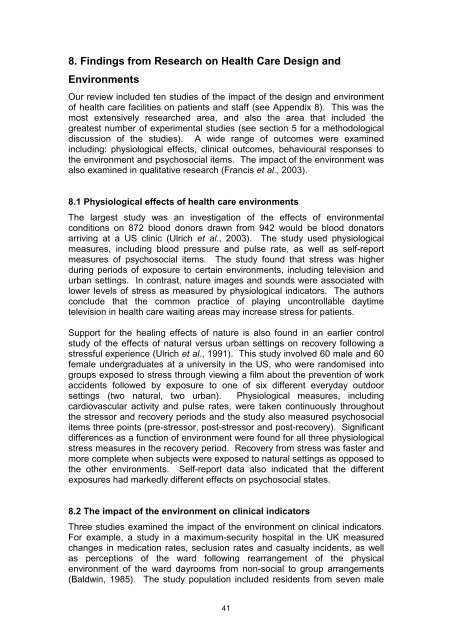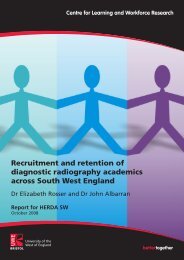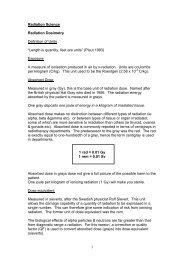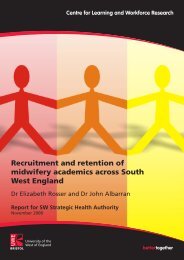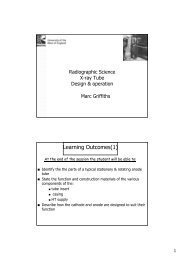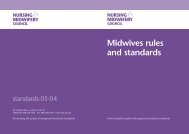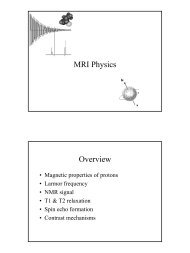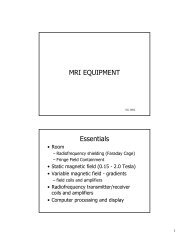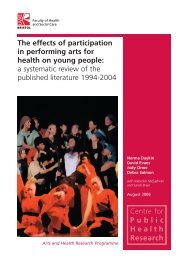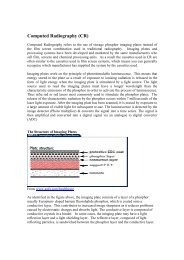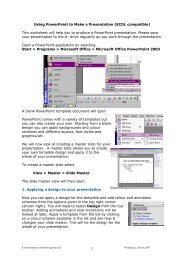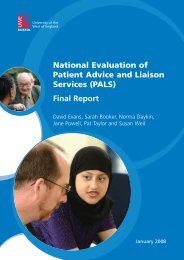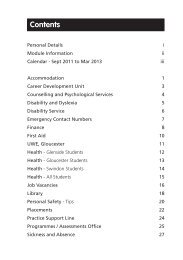Literature Review - HSC Home - University of the West of England
Literature Review - HSC Home - University of the West of England
Literature Review - HSC Home - University of the West of England
You also want an ePaper? Increase the reach of your titles
YUMPU automatically turns print PDFs into web optimized ePapers that Google loves.
8. Findings from Research on Health Care Design andEnvironmentsOur review included ten studies <strong>of</strong> <strong>the</strong> impact <strong>of</strong> <strong>the</strong> design and environment<strong>of</strong> health care facilities on patients and staff (see Appendix 8). This was <strong>the</strong>most extensively researched area, and also <strong>the</strong> area that included <strong>the</strong>greatest number <strong>of</strong> experimental studies (see section 5 for a methodologicaldiscussion <strong>of</strong> <strong>the</strong> studies). A wide range <strong>of</strong> outcomes were examinedincluding: physiological effects, clinical outcomes, behavioural responses to<strong>the</strong> environment and psychosocial items. The impact <strong>of</strong> <strong>the</strong> environment wasalso examined in qualitative research (Francis et al., 2003).8.1 Physiological effects <strong>of</strong> health care environmentsThe largest study was an investigation <strong>of</strong> <strong>the</strong> effects <strong>of</strong> environmentalconditions on 872 blood donors drawn from 942 would be blood donatorsarriving at a US clinic (Ulrich et al., 2003). The study used physiologicalmeasures, including blood pressure and pulse rate, as well as self-reportmeasures <strong>of</strong> psychosocial items. The study found that stress was higherduring periods <strong>of</strong> exposure to certain environments, including television andurban settings. In contrast, nature images and sounds were associated withlower levels <strong>of</strong> stress as measured by physiological indicators. The authorsconclude that <strong>the</strong> common practice <strong>of</strong> playing uncontrollable daytimetelevision in health care waiting areas may increase stress for patients.Support for <strong>the</strong> healing effects <strong>of</strong> nature is also found in an earlier controlstudy <strong>of</strong> <strong>the</strong> effects <strong>of</strong> natural versus urban settings on recovery following astressful experience (Ulrich et al., 1991). This study involved 60 male and 60female undergraduates at a university in <strong>the</strong> US, who were randomised intogroups exposed to stress through viewing a film about <strong>the</strong> prevention <strong>of</strong> workaccidents followed by exposure to one <strong>of</strong> six different everyday outdoorsettings (two natural, two urban). Physiological measures, includingcardiovascular activity and pulse rates, were taken continuously throughout<strong>the</strong> stressor and recovery periods and <strong>the</strong> study also measured psychosocialitems three points (pre-stressor, post-stressor and post-recovery). Significantdifferences as a function <strong>of</strong> environment were found for all three physiologicalstress measures in <strong>the</strong> recovery period. Recovery from stress was faster andmore complete when subjects were exposed to natural settings as opposed to<strong>the</strong> o<strong>the</strong>r environments. Self-report data also indicated that <strong>the</strong> differentexposures had markedly different effects on psychosocial states.8.2 The impact <strong>of</strong> <strong>the</strong> environment on clinical indicatorsThree studies examined <strong>the</strong> impact <strong>of</strong> <strong>the</strong> environment on clinical indicators.For example, a study in a maximum-security hospital in <strong>the</strong> UK measuredchanges in medication rates, seclusion rates and casualty incidents, as wellas perceptions <strong>of</strong> <strong>the</strong> ward following rearrangement <strong>of</strong> <strong>the</strong> physicalenvironment <strong>of</strong> <strong>the</strong> ward dayrooms from non-social to group arrangements(Baldwin, 1985). The study population included residents from seven male41


